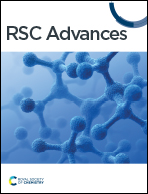A novel yttrium stabilized zirconia and ceria composite electrolyte lowering solid oxide fuel cells working temperature to 400 °C†
Abstract
Reducing the working temperature and improving the ionic conductivity of electrolytes have been the critical challenges for the gradual development of solid oxide fuel cells (SOFCs) in practical applications. The researchers all over the world attempt to develop alternative electrolyte materials with sufficient ionic conductivity. In this work, YSZ–CeO2 composite material was used as electrolytes in the construction of symmetrical SOFCs. The maximum power densities (Pmax) of YSZ–CeO2 based fuel cell can reach 680 mW cm−2 at 450 °C, 510 mW cm−2 at 430 °C, 330 mW cm−2 at 410 °C and even 200 mW cm−2 as the operational temperature was reduced to 390 °C. A series of characterizations indicates that the activation energy of the YSZ–CeO2 composite is significantly decreased, and the enhancement effect for ion conduction comes from interface transport. Our findings indicate the YSZ–CeO2 composite material can be a highly promising candidate for advanced low-temperature SOFC.



 Please wait while we load your content...
Please wait while we load your content...